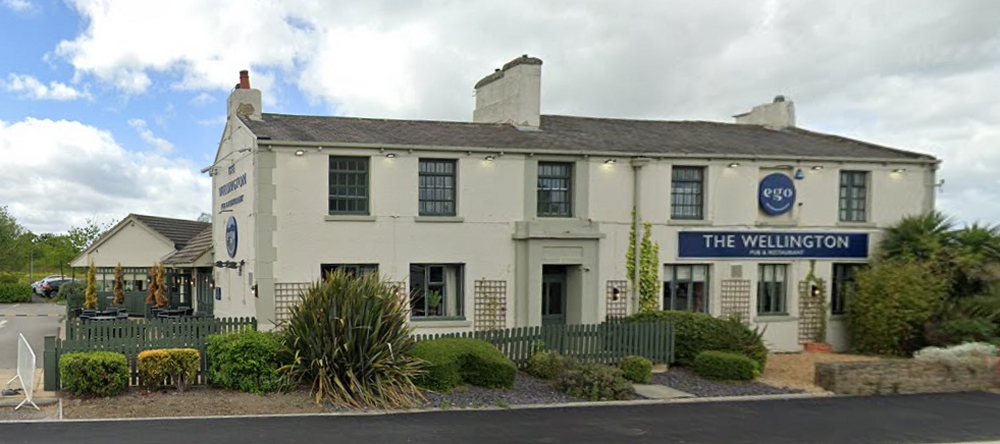 The Wellington Inn, Shadwell. 2022. It is probably quite surprising to many people that the popular Wellington Inn on the Wetherby Road near Shadwell, Leeds lies just within the ancient boundaries of the Parish of Barwick-in-Elmet. Yet despite its remoteness from the Parish centre, its history is tied up with and detailed within many of the surviving Parish records. To know its history, we must go back over two hundred years when the north-western portion of Barwick-in-Elmet Parish comprised the ancient moor and wasteland of Whinmoor. Some residents (commoners) had rights to graze cattle on this land, although in places it would have been a barren and boggy place. On the 6th October 1804 the Parish, including Whinmoor, was enclosed by a Private Act of Parliament titled "An Act for Dividing and Enclosing the several Open Fields, Ings, Commons, and Waste Grounds within the Parish of Barwick in Elmet in the County of York." Enclosing was a widespread practice in the 18th and 19th centuries with the primary reason it improved the efficiency of agriculture, but it also usually led to an increase in the value of the owner's landholding. Three Commissioners were appointed by the Act to complete all the necessary arrangements. It was a long time coming however, the Act had been passed by Royal Assent on the 14th May 1796 but it took 8 years to sort out the various claims and disputes, some of which related to the exact boundary of Whinmoor, particularly where it bordered onto Seacroft, then in the neighbouring Parish of Whitkirk, in the west. 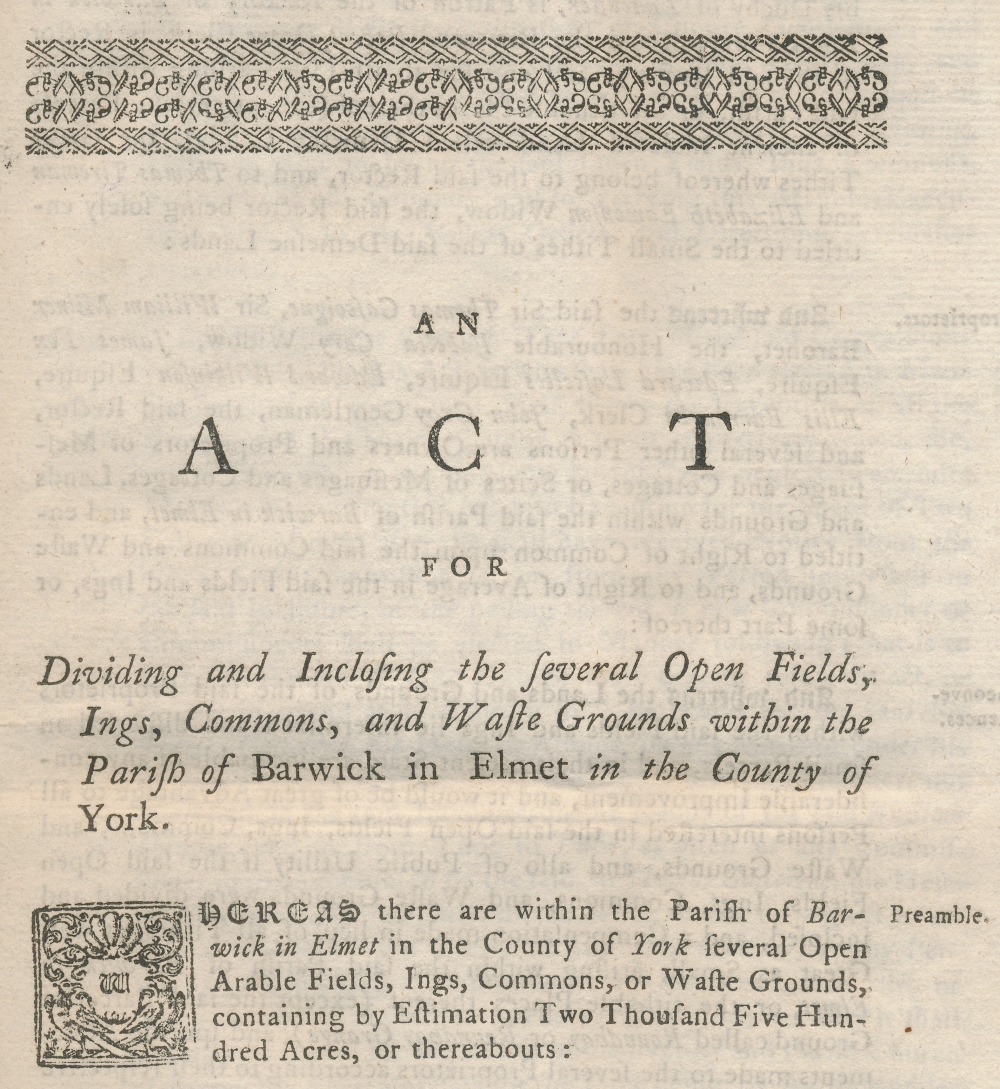 The 1796 Barwick-in-Elmet Enclosure Act (copy owned by the Barwick Historical Society). The open moorland of Whinmoor was parcelled up into allotments or fields of various sizes and these were allocated to people who had previously had rights to use the moor, usually because they owned ancient, already enclosed, land within the Parish. The tax of Church tithes (one tenth of annual produce or earning to support the local church and clergy) was also abolished in the Parish by the Enclosure Act and the Rector of All Saints Church, Barwick-in-Elmet, was given a large area of Whinmoor as additional glebe land to provide a rental income as compensation. The land on which the Wellington Inn was later constructed was part of Whinmoor and in the Enclosure Award document, which lists all the allotments allocated, it was part of a 53 acre allotment allocated to Richard Ramsden Bramley, Esquire (allotment number A62) detailed as follows: Description: Common near Red Hall, Parcel of Winn Moor, copyhold tenure, bounded on the East by Harewood Road, on the West by Alwoodley Road, on the North by the Township of Thorner and a Private Road and on the South by Red Hall Road. Richard R. Bramley to maintain the fences on the east, west and south.  Part of the Enclosure Award dated 6th Oct 1804 detailing the Allotment of R.R. Bramley. (Acknowledgement : WYAS, Leeds, WYL671 - West Yorkshire Archive Service - www.wyjs.org.uk/archives) Harewood Road is now known as the Coal Road, most of Alwoodley Road no longer exists and it was under Red Hall playing fields and now the ELOR road but parts of it and the private road mentioned are Whin Moor Lane. Red Hall Road is now called Red Hall Lane. All the roads were new and created by the process of enclosure to open-up the moorland and provide access. The land was copyhold tenure under the Manor of Barwick & Scholes, this meant that all transfers of ownership had to be completed through the Manor Court and the Lord of the Manor received a payment. The Gascoigne family of Parlington and later Lotherton were the Lords of this Manor.  6th October 1804 Barwick-in-Elmet Enclosure Map showing allotment A62 (copy recreated by the Barwick Historical Society). Richard Ramsden Bramley was born in Leeds in 1750 and was a town Alderman and Mayor of Leeds in 1792. He purchased a large estate of land and buildings in the Parish on the 31st May 1793 from Sir Henry Goodricke who had inherited it from his great-grandfather Robert Benson, Lord Bingley, the man who laid out the Bramham Estate. Richard R. Bramley's ownership of this estate entitled him to the allotments on Whinmoor when enclosure took place 13 years later. 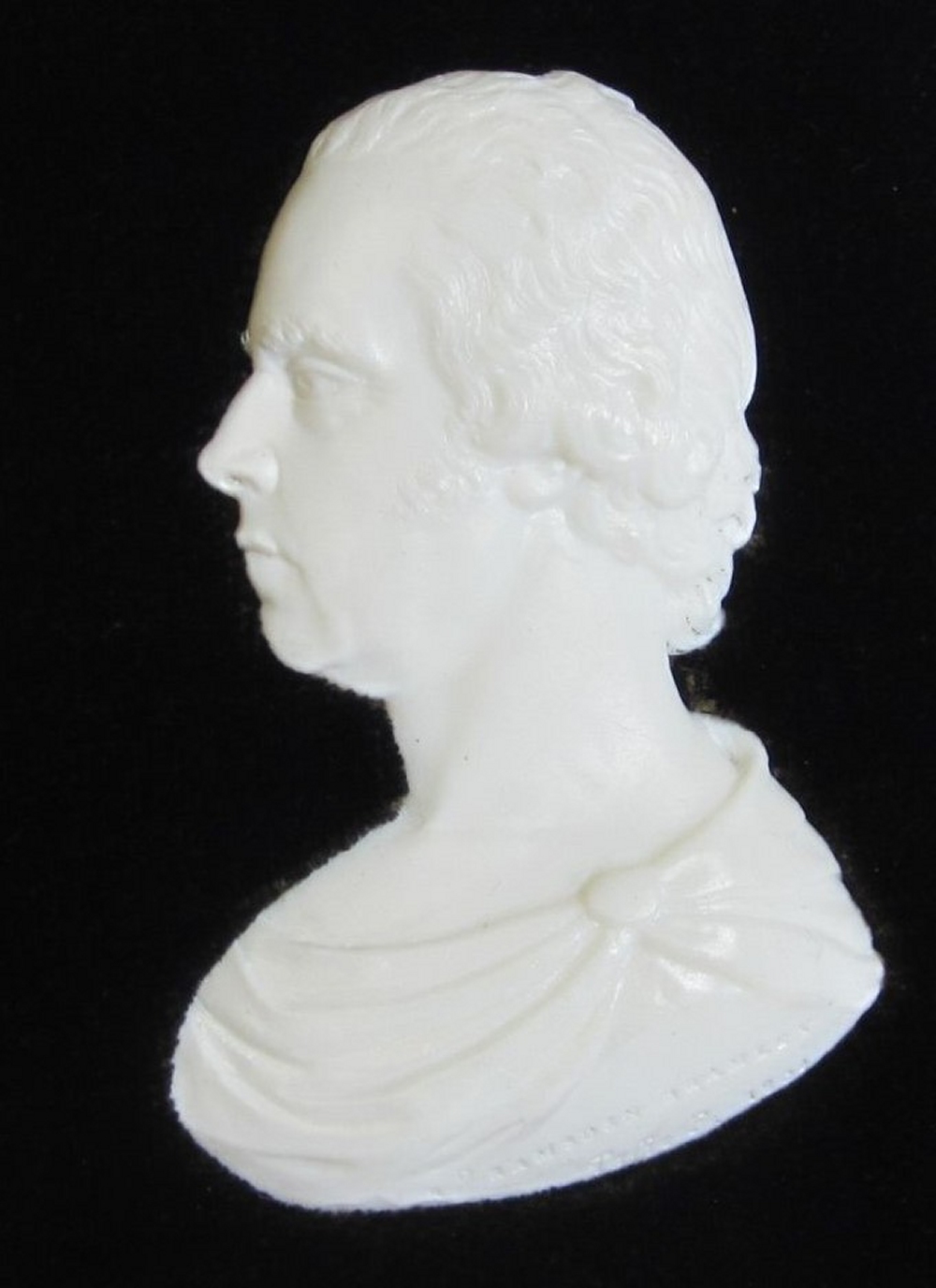 Plaque depicting Richard Ramsden Bramley dated 1804. Richard R. Bramley probably installed drainage on the moorland allowing it to be used for farming and split the 53 acres into smaller chunks. He sold the western half containing about 21 acres to William Simpson of Newton in the Parish of Ledsham on the 18th May 1805. William subsequently sold this land, along with other adjacent land he owned at Red Hall to Benjamin Atkinson of Manston on the 14th July 1821 for £1,534. Leeds was a rapidly expanding town at this time and needed better transport links. The routing, width and condition of many roads was terrible, some meandered through many villages and others became unpassable in winter due to mud. Turnpikes roads were created to allow new routes to be created. Tolls would be charged and the money used to build, improve, and maintain the road. In the 1820s it was decided that a new turnpike road would be constructed on the route between Leeds and Wetherby. In 1823 the section between Roundhay Bridge and Collingham was surveyed and an Act of Parliament, allowing the road to be built, was published along with plans and a book of reference listing all the landowners along the route from whom land would need to be compulsory purchased. This route went diagonally through the 21 acres owned by Benjamin Atkinson on Whinmoor. The Act was passed into law on the 28th May 1824 and the road constructed shortly after.  The Yorkshire Gazette - 12th February 1825 - Road-Makers required on the Leeds to Collingham Turnpike. In the period before the railways arrived the road would have been busy with horse-drawn traffic and this presented opportunities for roadside businesses to take advantage. Into our story comes William Wetherill of Birkby in Thorner and his wife Mary. To understand the sequence of events we must rewind to May 1792 when William Wetherill's father John, also of Birkby purchased a house called Hobberley and 3 closes of land containing 8 acres from Thomas Tate. This property was located just to the north of Wellington Inn site adjacent to the area of Hobberley Lane today and then close to Whinmoor. It was then a detached part of the Parish and Manor of Barwick-in-Elmet & Scholes. Ownership of this property gave John Wetherill commoners rights on Whinmoor and therefore at Enclosure in 1804 he was allocated just over 4 acres of land on the edge of the common close to his Hobberley House. John Wetherill died on the 3rd October 1807 and this land passed to his son William Wetherill. These 4 acres of land backed onto other land owned by Benjamin Atkinson at Red Hall and he appears to have wanted a clean edge to his estate in this area, so on the 4th May 1827 William Wetherill exchanged this enclosure allotment with Benjamin for just over 4 acres of the northern part of his 21 acre parcel. This parcel was described as: "2 pieces of ground now divided by the Leeds and Wetherby turnpike road containing as a whole 4 acres 3 roods 32 perches lately part of an enclosure allotment of 20 acres 3 roods 34 perches previously the estate of Richard Ramsden Bramley of Leeds."  Map showing lands exchanged between William Wetherill and Benjamin Atkinson in 1827. William Wetherill then built an Inn on part of this land on the western side of the turnpike road. The exact year of construction is unknown but the 1st reference to the Wellington Inn on Whinmoor is in "Whites Directory of the West Riding of Yorkshire" from 1838 when the landlord was one George Massey. Whilst there have been many alterations to the Inn during the years it is likely that some parts of this building may exist in the northeast part of the current premises. 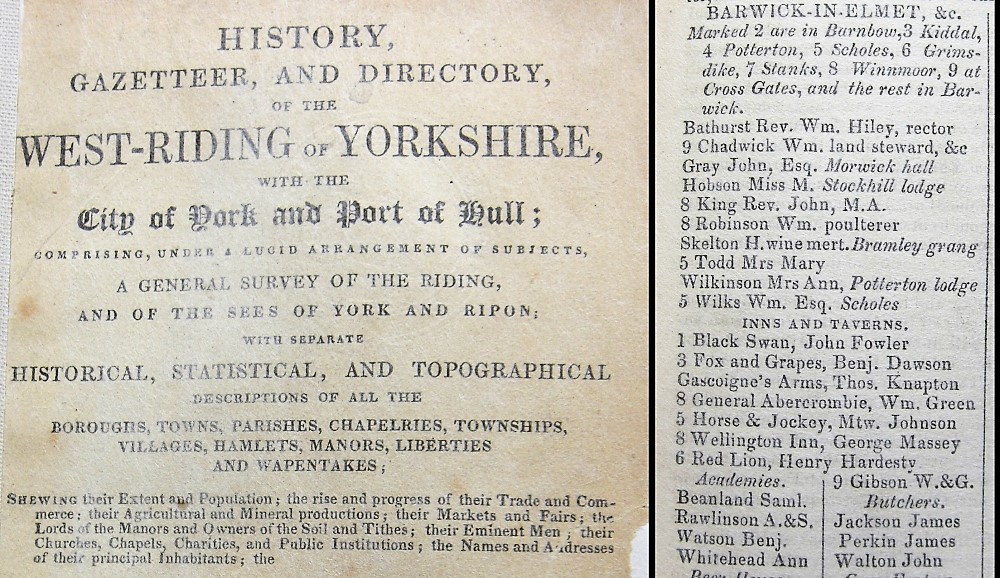 Whites 1838 Directory of the West Riding of Yorkshire - 1st reference to the Wellington Inn on Whinmoor. The name Wellington refers to Arthur Wellesley the 1st Duke of Wellington (1760-1852). He was an Anglo-Irish soldier and Tory statesman. He was a general at the Battle of Waterloo in 1815 when Napoleon was defeated ending the long running and crippling Napoleonic war. He became widely regarded as a nation hero. After his military service he entered politics and served as a Tory Prime Minister twice between 22nd January 1828 − 16th November 1830 and the 17th November 1834 − 9th December 1834. He was celebrated all over the Country with many memorials constructed, perhaps the most famous been the Wellington Monument (1822) and Wellington Arch (1830) which still exist in central London. In the 1820s/30s therefore, naming a newly constructed public house after the national hero would have been eminently suitable. 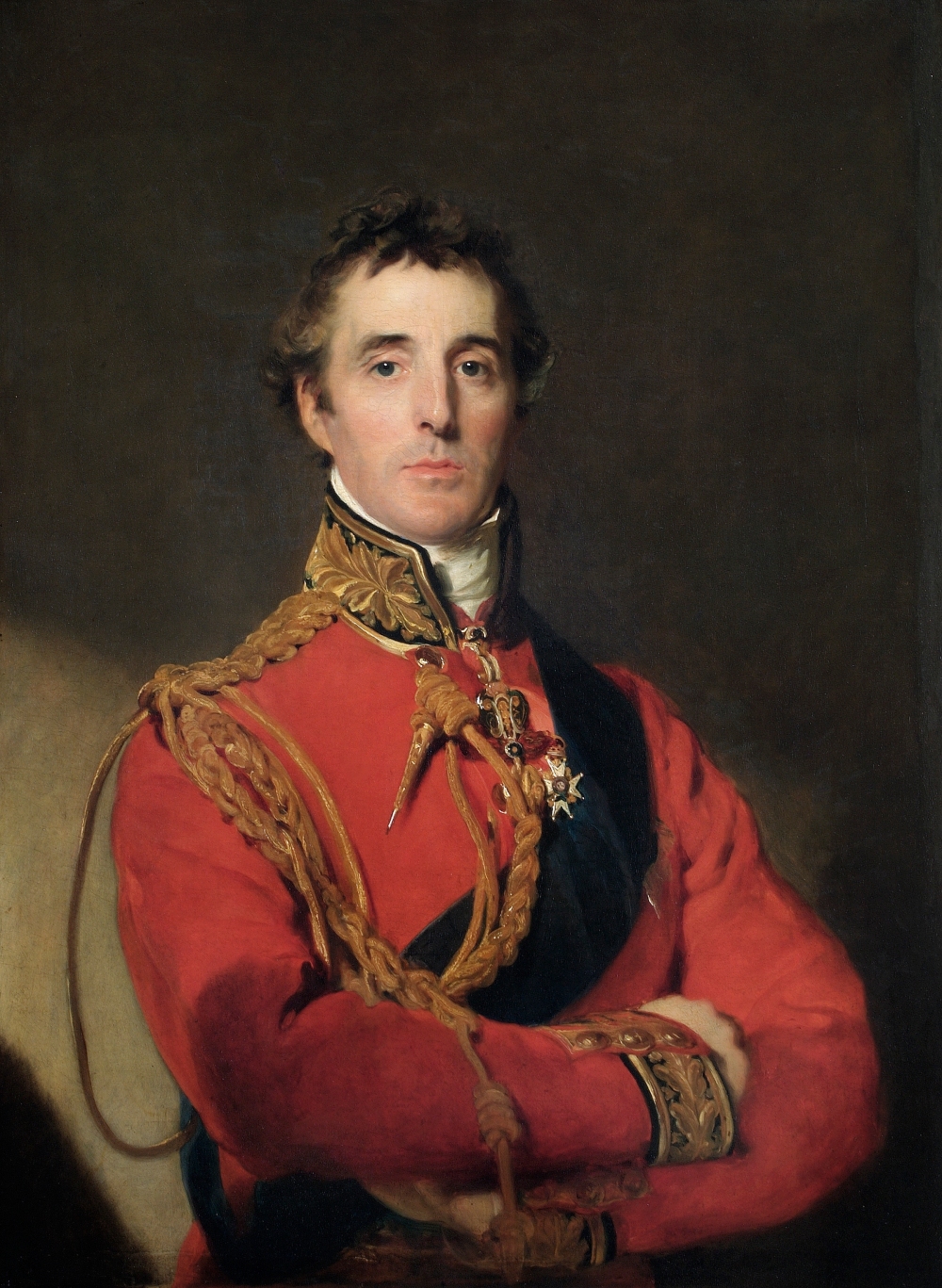 Arthur Wellesley, 1st Duke of Wellington c1815. By May 1841 Charles Askern was landlord renting the premises from William Wetherill along with 5 acres of land for the annual sum of £23 2 shillings 10 pence. In August 1841 they were described as "Public house, offices & garden, with land called front close, back close & far back close." William Wetherill died in October 1841 and ownership of the Inn passed to his son John Wetherill. 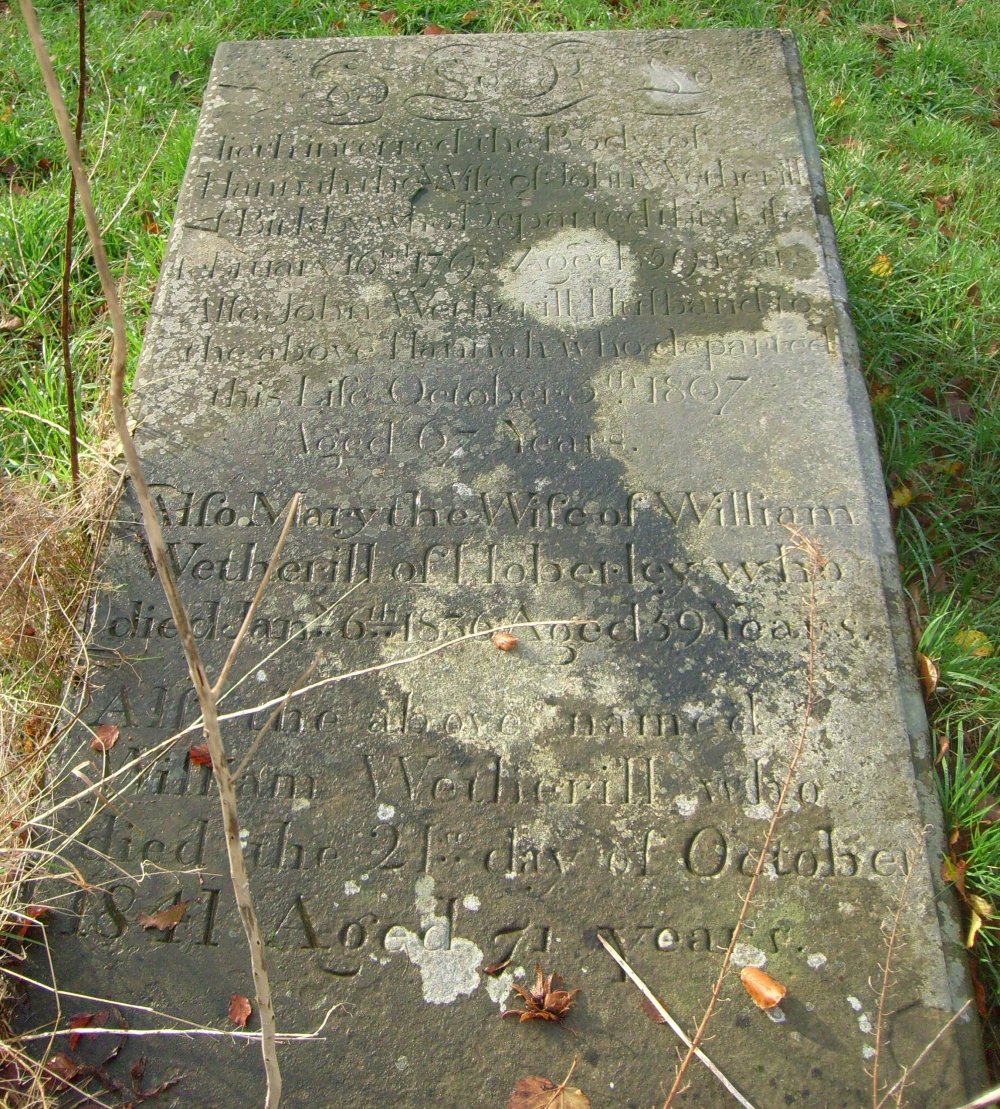 Gravestone of John Wetherill (1739-1807) & his son William Wetherill (1770-1841) who built the Wellington Inn. Thorner St. Peters Churchyard. John Wetherill sold the Inn on the 13th July 1846 to James Hague for £380 but retained the majority of the adjacent land himself, the premises he sold were described at the time as: "Dwellinghouse known as the Wellington Inn on Whinmoor with barn, stable, cowhouse, and other outbuildings and garden adjoining which buildings were erected by William Wetherill the father of the said John Wetherill on land formerly the property of Benjamin Atkinson, together with a right of road for all carts, wagons, carriage horses and all purposes over the road from Leeds to Collingham to Shadwell being northeast of the said public house" James Hague then became the 31-year-old owner-occupier and landlord of the Wellington, he was born in 1814 in nearby Bardsey, the son of a shoemaker and had married Mary Ann Hirst in Whitkirk the year before he purchased the inn. It is unclear how he came into the fortunate position of been able to purchase the Inn as no records of any mortgages are recorded in the archives. The value of many Inns around the country were dropping at this time as the horse drawn coaching trade was impacted by the construction of the railways. Indeed, even as he purchased the Inn the York and North Midland Railway were constructing a line between Church Fenton and Harrogate passing through Wetherby and this opened to Wetherby the following year 1847. Whilst Wetherby did not get a direct line to Leeds until the 1876 Cross Gates to Wetherby line was constructed trade on the Leeds to Wetherby turnpike road will have suffered as people and goods moved onto the new form of transport. It is possible the £380 he paid was a bargain price. 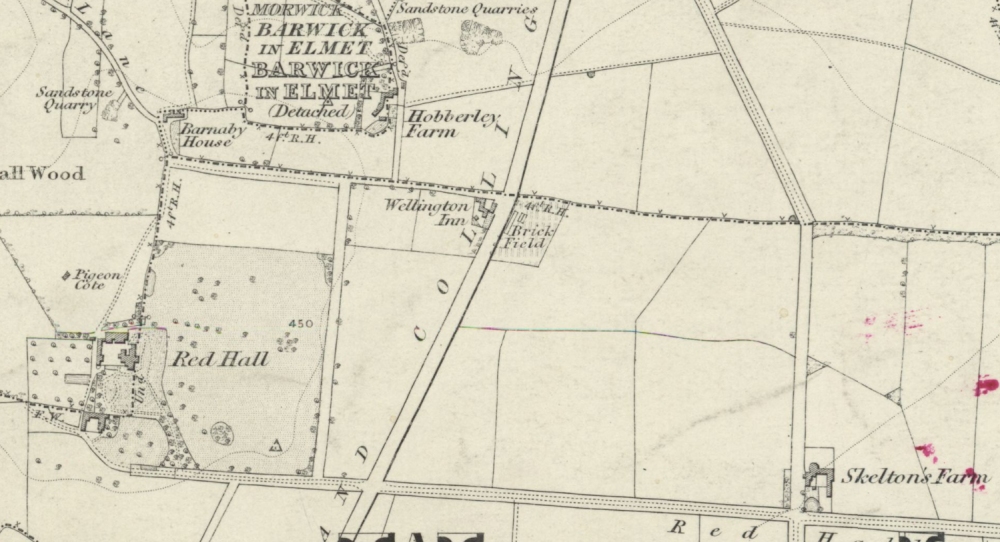 1847 Ordnance Survey Map showing the Wellington Inn. The Hague's appear to have quickly settled in to running the Inn and providing food and drink, occasionally a snippet of information survives in the archives. On the 18th November 1847 the annual meeting of "The Shadwell Agricultural Improvement Society" took place at the Inn, there were much discussions and displays of animals and vegetables for which prizes were awarded. It was reported that "Upwards of forty members and friends sat down to an excellent dinner at the Wellington Inn, provided in Mr. Haigh's usual liberal manner." James and Mary Ann Hague's son Edmund was born on the 8th January 1848 at the Wellington Inn and they remained running the business until at least 1857 but had left by 1861 when he was working as a cab driver and living in Leeds but retained ownership of the premises. He died in October 1868 and his widow Mary Ann retained a life interest in the property until she died in December 1877. The Wellington Inn then passed to their son Edmund Hague. During this time John Kirk had run the Inn around the years 1861 − 1867, he was born in Shadwell and ran the premises with an adjoining wheelwright and carpenters' business, living with his wife Elizabeth and had a large family. In 1861 John Wetherill whose father had built the Inn and who had sold it to James Hague in 1846 was living on the premises described as a gentleman border aged 53, he was widower. John Kirk had left by 1870 when William Derwick from nearby Seacroft with his Scholes born wife Ann ran the premises in the period 1870 − 1871. Shortly before his mother's death, from at least 1875 Edmund Hague took over as landlord. He had married Hannah Marie Stones from Askern, Doncaster in 1874 and they had 4 children at the Inn between 1875 and 1879. Eleanor in 1875, Gertrude in 1877, Hannah Marie in 1878 and James Edward in 1879. Sadly, Hannah Marie died at the Inn in March 1879 aged just 26 of tuberculosis leaving Edmund a widow with all the children under the age of five. Mary Jane Stones, Hannah's younger sister came to live at the Inn as a housekeeper and to help look after the children. In 1881 Edmund employed 16 years George Fowler, as an ostler (to look after the horses of people staying at an inn) using the stables at the rear of the Inn. Also located in this area was a blacksmith shop with blacksmith George Scott aged 23 providing his services. Tragedy struck the Hague family again when Edmund died on the 30th July 1882 aged just 34 again of tuberculosis.  Death Certificate of Edmund Hague - 30th July 1882. In his will the Inn was left in trust for his children, the trustees he appointed been his father-in-law Edward Halifax Stones of Askern, a grocer, brother-in-law Frederick Stones of Manchester, a baker and Martha Ann Stone, his sister-in-law. Rather than immediately sell the Inn Edward H. Stones moved to the Inn to become the landlord, he was joined by his daughter Martha Ann who joined his other daughter Mary Jane and the 4 young Hague children.  Leeds Times. 5th August 1882. Death Notice for Edmund Hague. Trustee of the will Martha Ann Stones died in April 1895 and the youngest Hague child and only son James Edward died in 1896 and therefore by 1899 the three remaining Hague girls were all aged over 21, married and entitled to their inheritance. The Inn was put up for auction on 22nd August 1899 when it was sold in Leeds for £5,100.  Gravestone of James Edward Hague of the Wellington Inn. Bardsey All Saints Churchyard. The purchaser was Henry Beeforth, a butcher by trade, he had married the middle Hague child, Gertrude in March 1895 and therefore ownership of the Inn remained in the family. 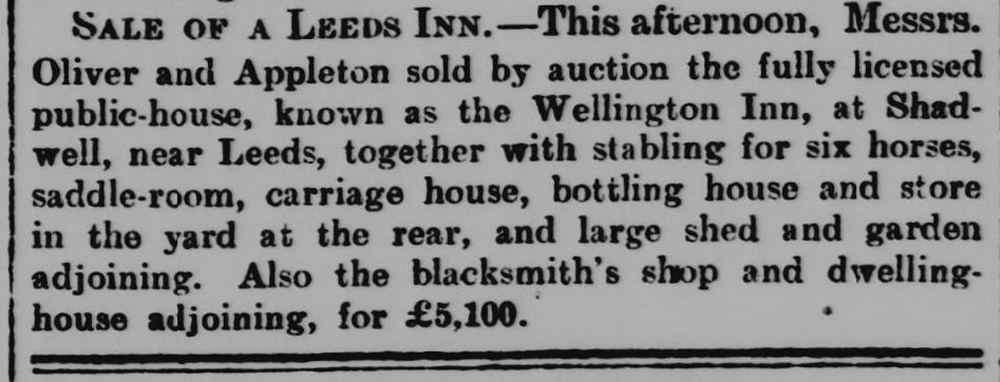 Yorkshire Evening Post - 22nd August 1899. The Wellington Inn is sold. Henry spent £500 on alterations including an extension alongside the Wetherby Road which contained a garage and concert room. Henry and Gertrude ran the Inn until 1909.  1906 Ordnance Survey Map showing the garage extension to the Inn. On the 12th August 1909 Henry obtained a licence from the Lord of the Manor of Barwick-in-Elmet & Scholes to lease the house for up to 30 years to the John Smiths Tadcaster Brewery, this large brewery had been acquiring houses for many years which it then supplied beer from its own brewery as a tied house. The 1st lease was for 7 years at an annual rent of £260. James Henry Chappel Varley from Leeds became the 1st landlord under the John Smith Company Ltd. 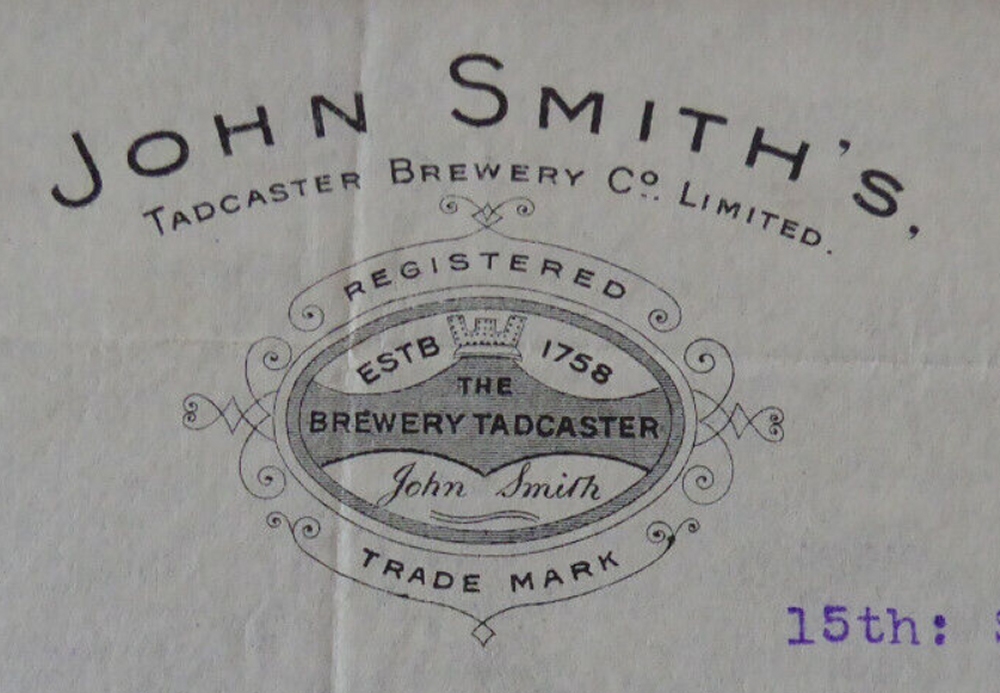 John Smith's - Lessee of the Inn from 1909. Around 1910 the Inn was valued and described as: Shadwell, Wellington Inn, 1190 square yards. Gross value land and buildings £120. Net £96. Occupier: John Smiths Tadcaster Brewery Co Ltd. Owner: H. Beeforth (copyhold - superior interest: Colonel Gascoigne) Occupiers Tenancy: 7 years from 12 August 1909. Rent £260 (subject to fine of £260 payable to Lord of Manor). Rates and Insurance: Occupier. Liable for repairs: Owner and Occupier. Description: Serving bar, tap room, best room - one glass roofed tearoom - 4 bedrooms + 2 storerooms (stone built good repair). Kitchen, Pantry & 2 beer cellars (one arched) Outbuildings: storeroom, washhouse, 2 slatt stables, loose box, 1 stall stable, saddle-room, 2 stall stables, loft over last four, coach-house, 2 privies & 2 loose boxes. also included 2 cottages - 1 occupied by John Smith Tadcaster Brewery and 1 by G. Scott On the 28th October 1913 Henry Beeforth, now living at and running an Inn in Harrogate paid the Lord and Lady of the Manor of Barwick & Scholes, Colonel Gascoigne of Lotherton and his wife Laura £600 to enfranchise the land and free it from all the historical Manorial restrictions. It then became a freehold property. The John Smith's lease was extended, and several landlords ran the Inn during the 1910s and 20s: − James H.C. Varley until 21st July 1914 − George Shepherd 11th August 1914 − 3rd September 1918 − Alice Shepherd 3rd September 1918 − 6th May 1919 − George Shepherd 6th May 1919 − 2nd January 1923 The Beeforth's sold the Inn in 1923 with an auction taking place on the 3rd October 1922, the new owner was Elizabeth Hillerby of Hunslet, Leeds, although Henry Beeforth did provide some of the money and retained a mortgage charge over the premises. Also providing money and taking a mortgage charge over the premises were William Whitaker & Co Limited, a brewery of Bradford, who no doubt took over from John Smiths in supplying the drinks. 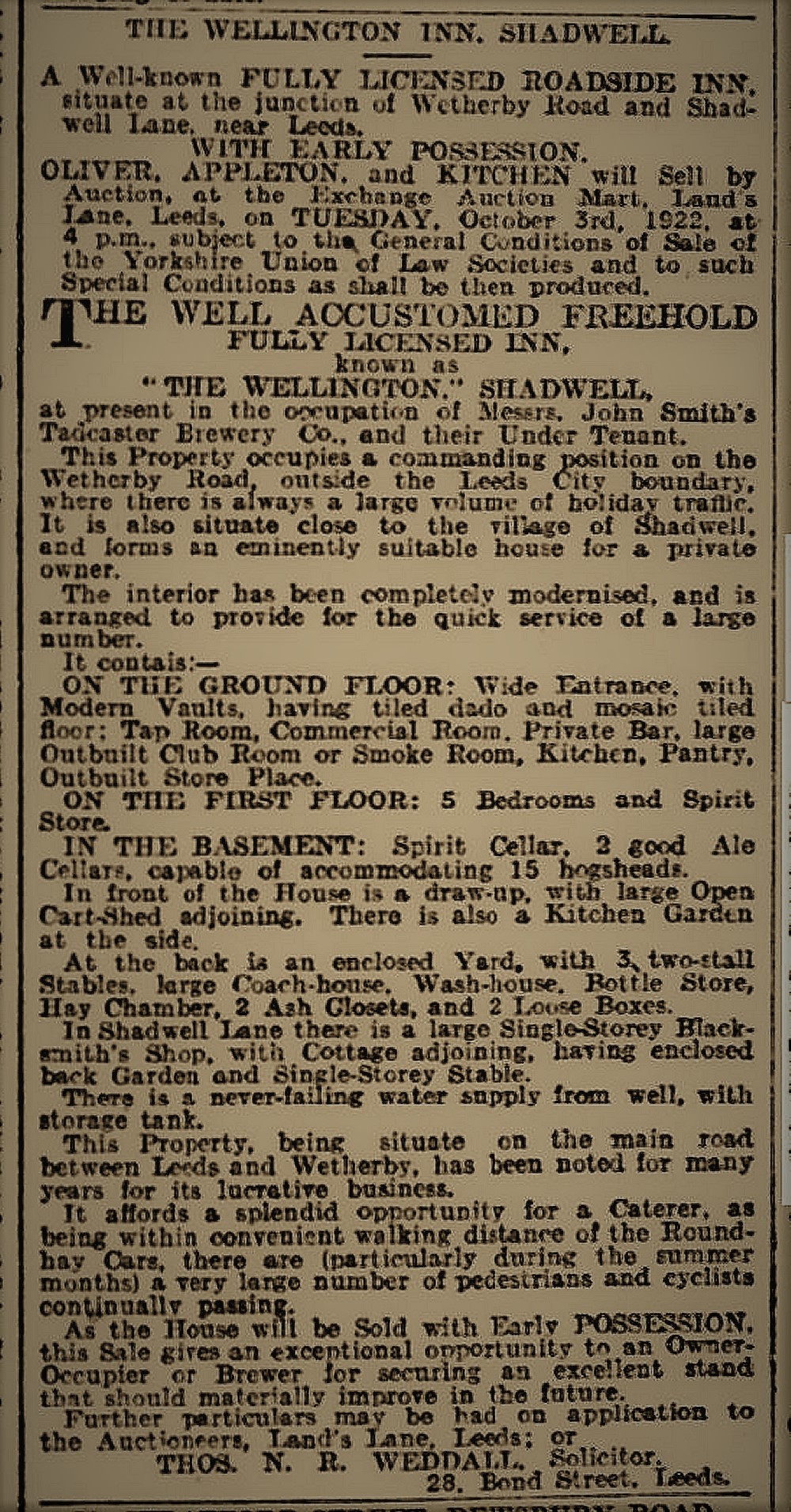 Yorkshire Post - 23rd September 1922 - The Wellington Inn is up for Auction. Elizabeth Hillerby married Frederick Elkington in July 1926. She was fined £5 in May 1926 whilst at the Inn for selling alcohol during prohibited hours with the then very strict licensing laws. During this period the latest transport phenomenon had really taken hold with the internal combustion engine and cars, lorries and buses starting to take over from the railways and horse drawn carriages. The garage at the front of the Wellington was leased to Arthur Edwards and in 1925 plans were approved to double its width and provide 3 petrol pumps with associated storage tanks. It is unclear whether these plans actually took place and the pumps installed. Elizabeth Elkington remained the landlady until January 1928. On the 30th January 1928 the mortgages provided by William Whitaker & Co Ltd and Henry Beeforth were both paid off and the premises sold to William Whitaker & Co Ltd.  William Whitaker & Co Ltd - Owners of the Inn from 1928. James Oddy took over as landlord now under Whitaker ownership. In April 1929 approval was given again for petrol pumps and fuel storage adjacent to the garage attached to the Inn but again it is unclear whether they were ever installed. New outdoor toilets, including a separate ladies were also approved for the Inn in 1929. Harry Proctor took over as landlord on the 28th July 1931. The following year 1932 was a significant year in the history of the Wellington Inn. Whitakers got approval and completed a massive number of alterations and extensions to the premises. The attached garage that was alongside Wetherby Road was removed and a new extension wrapping around the southwestern side of the existing premises was added. This included a new lounge, commercial room, toilets, scullery, and kitchen. The existing detached garages, stores, wash house and old cottage probably comprising part of the old blacksmiths and wheelwright shop were initially retained but new plans were approved in January 1933 for these to be demolished and 2 new garages to be built with a coal store. The remaining garden was tarmacked for use as a car park. The land surrounding the Inn had passed though various hands since it was retained by John Wetherill back in 1846. The brewery could obviously see that in the age of the motor car that a large car park and space for additional buildings or extensions would be important and so on the 7th February 1947 they purchased an additional 10,689 square yards of land wrapping around the Inn on the south and west sides from the estate of the late George Thomas Scott for £2,405 6d. Harry Proctor left in 1949 and Laurence Austin Caine took on the licence on the 9th August, further alterations to the premises were approved in 1950 and 1953. On the 1st April 1957 as a result of the Leeds Corporation Act 1956 the boundaries of the City of Leeds were extended and the Wellington Inn moved under Leeds City jurisdiction previously it have been under Tadcaster Rural District Council. William Whitaker & Co Ltd were taken over by the much bigger brewery, Joshua Tetley & Son Ltd of Leeds in 1959 and ownership of the premises transferred to them on the 20th September 1960.  Joshua Tetleys Brewery of Leeds took over the Inn in 1960. Many people have been involved in the Inn over the last 60 years and numerous alterations including: − 1st October 1965 − Laurence Austin Caine left. − 1st October 1965 to c1974 − Jim Royce landlord.  c1970 view of the Inn under Joshua Tetleys Ownership. − c1974 to c1977 − Charles Routledge landlord. − November 1979 − A new porch approved at the rear of the premises. − c1977 to c1991 − Jeffrey & Carol Bell landlord and lady. − October 1990 − Alerations and extension approved to form new lobby at the rear. − c1991 to c1998 − Norman & Marilyn Redshaw landlord and lady. − c1998 to c2000 − David A. Young landlord. − c2000 to c2001 − Frederick & Julie Cliff landlord and lady. By the 1980s brewing and pubs in the UK had come to be dominated by giant companies known collectively as "The Big Six" which including Joshua Tetleys. Starting in 1989 the Government, on recommendations from the Monopolies and Mergers Commission, decided to cut the breweries hold over public houses and they were forced to start to sell their estates of public houses. I have not been able to discover the exact details of the disposal of the Wellington Inn, it was still owned by Joshua Tetleys in 1993 but by 2002 was owned by Six Continents Retail plc. This large hospitality group owned pubs, hotels and restaurants. In 2003 it de-merged and split away its pub business into a company called Mitchells & Butlers plc. As of August 2022, this company still owns the Inn. In the 2010s the Inn ran as a Stonehouse restaurant.  Photographs of the Wellington Inn from the 2010s. On the 3rd June 2019 it was leased to Ego Restaurants Holdings Limited and opened as EGO at The Wellington, Shadwell on the 18th July 2019. This popular pub & restaurant now provides Mediterranean food, cocktails, and local cask ales as it continues to quench the thirst and satisfy the appetite of locals and travellers as it has for over 180 years. Dave Teal December 2022 Back to the top Back to the Main Historical Society page Back to the Barwicker Contents page |